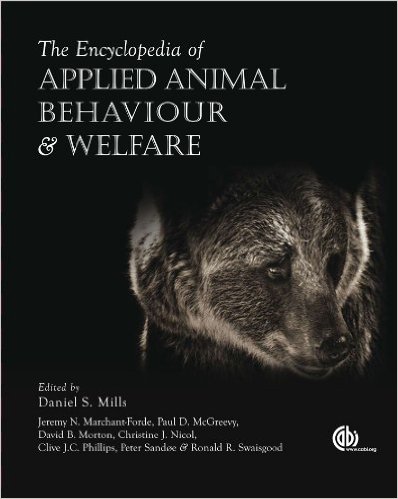
Encyclopedia of Applied Animal Behaviour and Welfare
This weighty encyclopedia provides definitions and explanations of key concepts and topics in animal behaviour and welfare. It’s set out in alphabetical order so you’ll find entries like ‘Central Nervous System’ after ‘Breeding’, ‘Dominance’ after ‘Confinement’, and ‘Hierarchy’ after ‘Grazing Behaviour’ and before ‘Immune Systems’. This encyclopedia is invaluable as a reference work, for checking that you do really understand certain terms – especially important when the same term has more than one accepted definition.
If you try to read the book straight through, sometimes it feels like you’re jumping all over the place, say, from research methods to the practicalities of housing animals, but of course, organizing entries in alphabetical order does make it easy to look up any particular term. There are also short essays which look at key concepts in depth, and there’s extensive cross-referencing, which means that you can follow up related terms, if you want to get a fuller picture of any topic. This makes the encylopedia fascinating as an in-depth guide to a wide range of topics from different fields, such as ethology, phylogeny, and animal husbandry, including how they have developed over time, and current concerns.
The approach aims to improve understanding of work in different disciplines for people who have no option but to take a multi-disciplinary approach. Animal behaviour specialists interested in cognition are sometimes rude about behaviourism, while behaviourists are sometimes rude about ethology. While bang on the table arguments that emphasise differences between approaches can be fun, it can also help to see how different approaches might fit together, and sometimes even complement out another, rather than being mutually exclusive.
The aim of the book is to promote practices likely to enhance welfare in companion, farm and zoo animals. Understanding animal welfare means understanding animal behaviour in a broad sense, as well as signs of compromised welfare, such as indications of stress. Research, and examining ethical and practical issues, can point to good practices for anyone involved in caring for animals, like farmers, vets, shelter workers, as well as those who make recommendations for regulations.
The main editor of the encyclopedia is Professor Daniel Mills from Lincoln University. The key contributors are listed above as authors, though there are some 180 contributors in all, including Katherine Houpt, Juliet Clutton-Brock, and Helen Zulch.
Who is likely to find this book useful? Anyone who wants to understand concepts in animal behaviour, and any professional dealing with animals. The book is horrendously expensive for most people, though it’s possible to find slightly damaged copies that are much cheaper than the price for a new and pristine copy. The price, alas, is likely to restrict the readership of this book, which is a very useful resource for people exploring animal behaviour.


